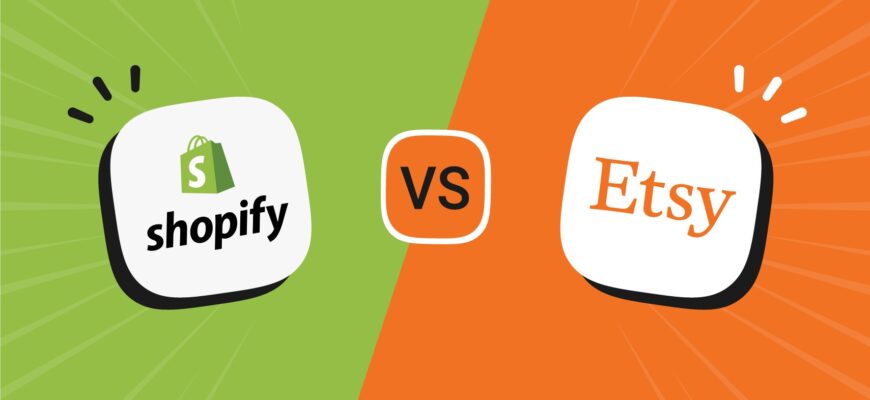- What is better for an online store: Shopify vs Etsy
- Usability and design
- ECommerce Features
- Extensions and plugins
- Technical support
- What products can I sell?
- The possibility of linking your own domain
- Payment gateways
- Dropshipping
- Which platform is better for promotion, Etsy or Shopify?
- SEO
- Contextual advertising
- Content marketing
- E-mail newsletters
- Etsy and Shopify Cost Comparison
- Shopify tariffs
- Etsy fees
- Which to choose, Shopify or Etsy?
- The advantages and disadvantages of Etsy
- Pros and cons of Shopify
- Can I use Shopify together with Etsy for eCommerce?
Shopify and Etsy are two of the most popular platforms for creating an online store. Each of them has its own features and advantages. In this article, let’s look at the main advantages and disadvantages of these two giants of the e-commerce world and help you decide which platform is better, Shopify or Etsy.
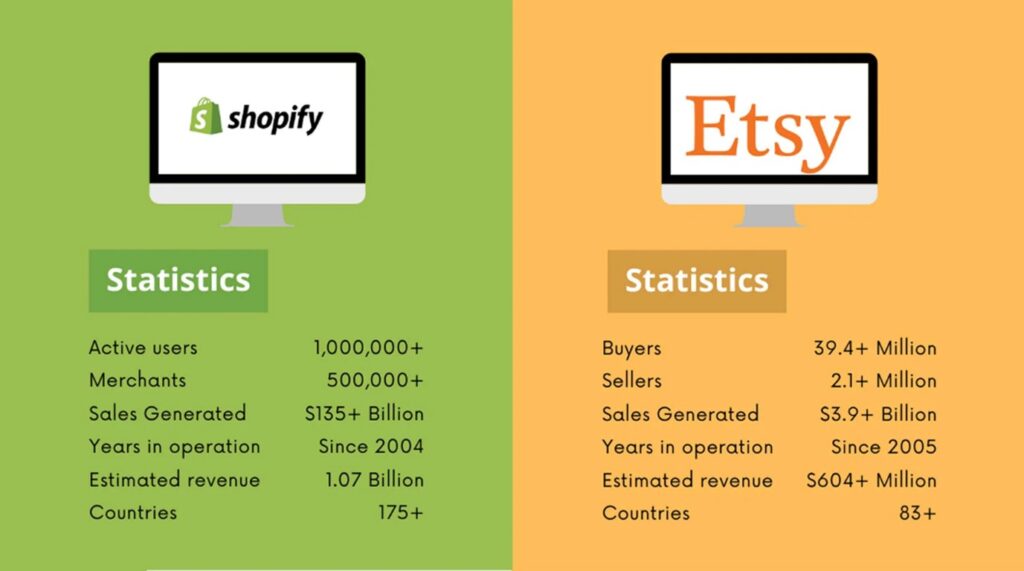
What is better for an online store: Shopify vs Etsy
Choosing the right platform for online commerce in today’s retail environment is critical to the success of your business. Below, let’s take a look at the price to use, features and built-in functionality, and figure out which is better for eCommerce, Etsy or Shopify.
How many calls and sales will I get by ordering contextual advertising from you?
I need to calculate the conversion of my website Describe
the task
in the application
Calculate potential ad revenue Google
contextual advertising calculator
Usability and design
Shopify is loved for its simple and intuitive interface. The CMS has many ready-made templates built in to customize the look of the store, so you can create a unique and professional design without the need to know HTML and CSS.
The registration and customization process is very simple, so sellers can quickly add products and receive their first orders. Integration with third-party applications is also available, which make it easier to manage the resource and automate many processes.
For Etsy, registering an account and uploading the first items will not take long. However, here you will not be able to create a custom design, and will have to settle for a standard design, which somewhat limits the possibilities for the seller.
At the same time, the platform is perfect for small businesses and independent sellers who are engaged in handicrafts and other types of creativity.
ECommerce Features
Etsy focuses on the promotion of handmade and vintage goods. It has basic eCommerce features that give you the bare minimum you need to trade online:
- A simple process for adding products;
- Mobile application for managing orders and communicating with customers;
- Integration with payment services and delivery services;
- Reviews and ratings to increase trust in the company.
At the same time, the possibilities for integration with third-party services are very limited. There are also certain restrictions on the product categories that can be added to the site.
Shopify, on the other hand, is a full-fledged e-commerce CMS that provides all the tools you need to run an online store in any subject. Here you can find:
- A wide selection of design templates and design themes;
- Mobile application for store management;
- Its own online payment system, as well as extensive opportunities to customize delivery terms;
- Built-in marketing tools;
- Analytics and reporting to track orders and visitor behavior;
- A wide range of third-party applications to expand functionality;
- Ability to create an unlimited number of products and their variations (color, sizes, etc.).
Extensions and plugins
This is where Shopify has a significant advantage – the plugin store has over 6,000 apps available for all tastes (both free and paid). They are divided into 12 categories, which makes it much easier to find the right tools.
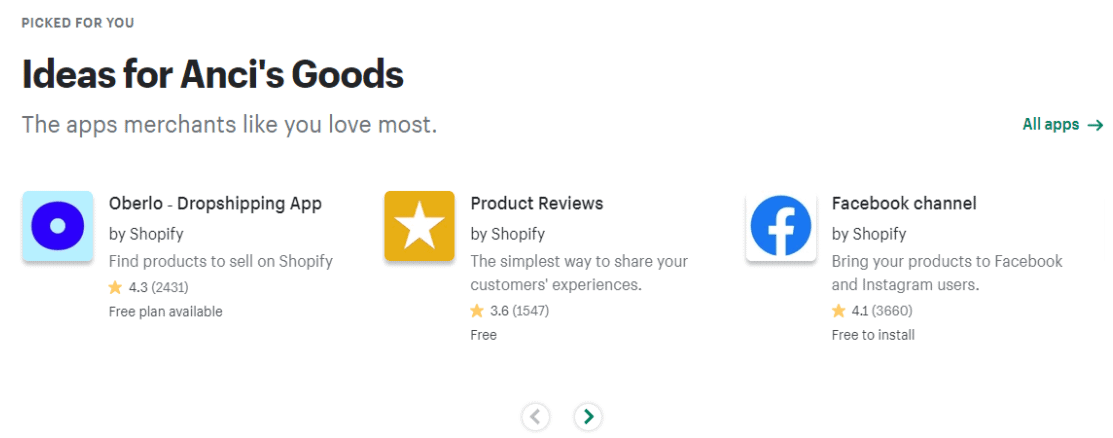
The range of extensions is extremely wide. They help in integrating with dropshipping platforms and social networks, creating countdown timers for implementing promotions and sales, connecting loyalty programs, managing mailings, etc.
In fact, you will be able to find solutions for any task related to the functioning of your online store. In addition, you can even connect your Etsy store to Shopify, uniting them into a single system.
Etsy, on the other hand, does not have its own app store. However, there are third-party marketplaces and independent developers who produce add-ons for Etsy stores. That said, their selection is not as large and integrations are a bit more complicated.
Technical support
Both platforms have extensive help documentation including articles, guides and tutorials. The Etsy site also has a detailed, searchable seller knowledge base covering all aspects of interacting with the site.
However, it’s probably not possible to talk to a real expert and tell them about your problem (this option is only available in a limited number of cases). For the most part, sellers have to rely on the help center, community forum, and help from other users.
But for merchants on Shopify, there is unlimited 24/7 tech support via multiple channels: online chat, email, and phone. You can get in touch with a live consultant at any time of the day or night and quickly get help with your issue.
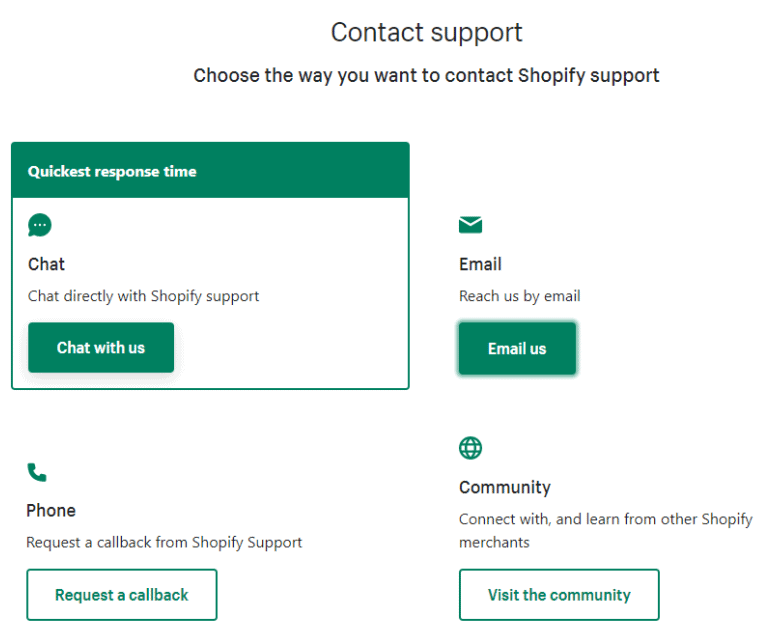
This way, you don’t have to worry about being on your own in case of any malfunctions or questions – technicians are always on call at any time of the day or night.
What products can I sell?
On Shopify you can sell any goods that do not violate the laws of the country in which the online store operates and the rules of the platform itself. The platform is suitable for trading in any niche and any goods. Among the most popular topics are clothing, electronics, cosmetics, and food.
But Etsy is a highly specialized marketplace focused on certain categories of goods. You can only sell here:
- Handmade items. These can be jewelry, decor items, furniture, dishes, toys, etc.
- Vintage items from 20 years old. At the same time, “distort” information about the age is unlikely to get – for this is closely monitored by administrators.
- Goods for needlework. This includes materials, tools and accessories such as fabrics, beads, paints, blanks and more.
All categories have their own rules and restrictions. As an example, sellers of handmade goods must create their own goods and not resell someone else’s. It is not acceptable to pass off goods produced by someone else as their handiwork.
Thus, if you sell electronics, clothing from famous brands, or goods for animals, it is better to choose Shopify. But the administration of Etsy strictly monitors compliance with the theme when adding a new store. But it has a large loyal audience in its niche.
The possibility of linking your own domain
A domain name is the address of a resource on the Internet, which users enter in the browser to get to the store. Having your own domain name increases the trust of your visitors and allows you to create a recognizable brand.
You can easily link your domain name to your online stores on Shopify. This is done directly in the personal area of the platform and does not require any special technical knowledge. Additionally, an SSL certificate can be issued for free on Shopify. This allows you to create a secure connection when accessing the site, which guarantees the safety of personal data of visitors.
But you will not be able to bind your own domain to Etsy. This is due to the very specifics of the platform – it works as a single marketplace that hosts the pages of many sellers. A store on Etsy will have an address like www.etsy.com/shop/название-магазина.
Payment gateways
The built-in Shopify Payments payment system is already integrated with the online store. You can use it to accept payments with minimal fees.
In addition, it is possible to use more than 100 payment gateways, including PayPal, Stripe, Amazon Pay, Apple Pay and many others. Thus, customers can pay in any way they like.
How many calls and sales will I get by ordering contextual advertising from you?
I need to calculate the conversion of my website Describe
the task
in the application
Calculate potential ad revenue Google
contextual advertising calculator
Etsy Payments also makes it possible to accept payments from buyers with support for multiple currencies. You can pay by credit card, PayPal, Apple or Google Pay. However, integration of third-party payment gateways is not possible.
Dropshipping
With this business model, the seller does not need to store the goods in a warehouse and ship them himself. This function is taken over by the supplier. There are many extensions available in Shopify that allow you to connect dropshipping. Among them are Oberlo, Printful, Spocket and many others.
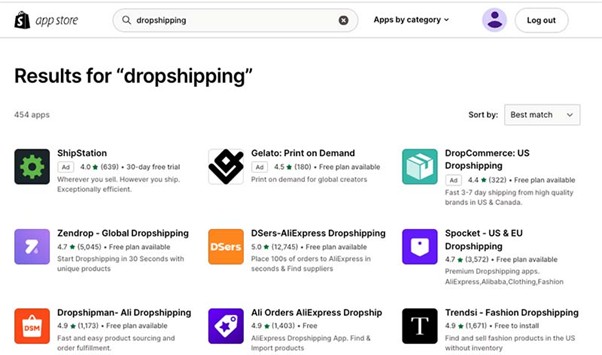
On Etsy it is also possible to work on the dropshipping scheme, but the seller must provide the administration of the platform with all the information about its suppliers and partners and get approval from it for such a variant of cooperation.
Which platform is better for promotion, Etsy or Shopify?
Without effective marketing and visitor engagement, there will be no sales, even if you have the best price and terms on the market. That’s why the marketing capabilities of the platform are so important to consider when choosing the right CMS. Next, let’s understand which is better, Shopify or Etsy, in terms of promoting your online store.
SEO
Search engine optimization has a direct impact on search engine visibility, number of visitors and leads. Shopify takes into account all of Google’s requirements and provides excellent functionality for internal optimization. It has:
- Built-in tools to manage meta tags (title and description);
- Support for CNC-URL and proper structure for better indexing;
- Ability to add alternative text (alt) to product photos;
- Integration with Google Analytics and Search Console for traffic analysis and indexing management;
- Many third-party extensions for more sophisticated optimization if the basic functionality is not enough for you.
Since Etsy is more of a marketplace than a standalone CMS, search engine optimization options are somewhat limited. But the basic functions are still present. You will be able to:
- Customize product meta tags, which helps to increase their visibility in search engines;
- Automatically generate URLs for product pages based on their names (you will not be able to edit the resulting URL);
- Add alt tags for images.
But you won’t be able to customize the site structure to your needs. You will also not be able to connect Google Search Console and Analytics.
Contextual advertising
In Shopify the choice of tools for advertising campaigns is much wider – you can use Google Ads and advertising capabilities of Bing, as well as extensions and plugins for sending statistical data from the site to advertising and analytical systems (Google Analytics and others).
In Etsy, the user will have access to another internal tool, Etsy Ads, which allows you to promote goods to the audience of the platform itself. You can still run contextual advertising in Google or targeting in Facebook, but with the analysis of results and optimization of campaigns can be difficult due to the inability to fully connect analytics systems.
Content marketing
In terms of adding informative articles about your products and blogging, Shopify wins by a wide margin. It provides:
- A built-in blog where you can publish articles and news;
- Possibility to link the site with third-party platforms for email distribution (Mailchimp and others);
- Creation of information and navigation pages (“About Us”, “Contacts”, “FAQ”, etc.);
- Uniqueizing the template for each type of page listed above to present the content to the user in the most attractive way possible.
On Etsy, the opportunities for content marketing are severely curtailed. In fact, this functionality is not provided. The platform allows you to add information about the store and links to social networks, where further interaction with the audience is supposed to take place. It is not possible to blog or connect an email newsletter on this platform.
E-mail newsletters
Unfortunately, Etsy does not provide any tools for organizing email newsletters. Sellers on the site have to use third-party services and manually import their subscriber base, which is quite inconvenient and time-consuming.
Shopify, on the other hand, features a powerful built-in toolkit for customizing email marketing, which is available right from the admin panel. Thus, you don’t need to connect third-party services and spend time integrating them – everything is already ready to use.

Moreover, Shopify provides merchants with a lot of ready-made templates for email design. They automatically adjust to the store design, pulling in brand colors, logo, and products. All you have to do is write the text, add images and the newsletter is ready.
At the most basic rate in Shopify, you can send up to 2,500 free emails per month. That’s more than enough to reach your entire subscriber base without incurring additional costs.
Etsy and Shopify Cost Comparison
One of the main factors that entrepreneurs consider when comparing Shopify and Etsy is cost. After all, the cost of keeping the site up and running and commissions can have a significant impact on a business’s profits.
Shopify tariffs
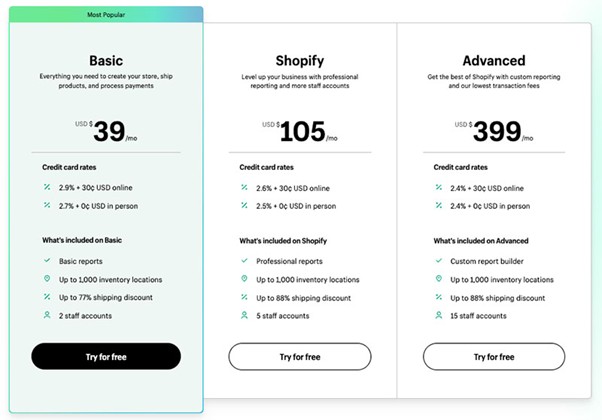
There is a fee to use the CMS, but there is a 14-day trial. During this time you can familiarize yourself with the main features and decide whether it is worth switching to a paid plan. There are three plans in total:
- Basic ($29/month). Suitable for beginners and small businesses. It includes all the basic features to create and launch an online store. You can add an unlimited number of product items, you get two accounts for employees, also included in this amount is 24/7 support, SSL certificate.
- Shopify ($105/month). Suitable for those who need additional functionality. In addition to Basic, it includes professional reports, lower payment processing fees, support for gift coupons and flexible shipping rates. Up to 5 accounts can be created for employees.
- Advanced ($399/month). Designed for large and fast-growing businesses. Here you can connect separate accounts for 15 managers and advanced analytics. The transaction fee is even lower here. You can also set up integrations with shipping services to calculate their fees in real time.
Etsy fees

Etsy is more attractive to small businesses and individuals selling their handmade goods due to the lack of monthly usage fees. At the same time, the site charges fees for listing items in the catalog and for each transaction:
- Fee for adding an item. For $0.20 you can add a new product to the site for 4 months or until it is sold.
- Commission per sale. Provided at a rate of 5% of the value of each item sold (including shipping and packing costs).
- Transaction Fee. When paying via Etsy Payments, there is also a commission fee. The amount depends on the country where the bank account is registered. It can range from 3% to 4.4% plus a fixed amount per transaction.
Which to choose, Shopify or Etsy?
Each system has its advantages and disadvantages and may be the best choice in one case or another. Let’s take a look at the features of each platform to see what to choose, Etsy or Shopify.
The advantages and disadvantages of Etsy
Etsy is interesting, first of all, its themed community. If a person visits this marketplace, they are mostly looking for products of a certain type, which increases the conversion to order for those categories. Let’s consider the other advantages of this marketplace:
- Target audience. If your hobby is to create things with your own hands, then your abilities can be appreciated by the audience of this site. And it will be much more effective than promoting handmade on general thematic marketplaces.
- Ease of use. The interface is simple and intuitive, which means that even a novice in e-commerce can cope with it.
- No subscription fees. The service does not charge a monthly fee for use, which can be attractive to small sellers and those who are just starting their business.
- Active community. This allows not only to sell handmade goods, but also to share experience with the community, get advice and support from colleagues.
But this platform also has certain inconveniences:
- There are no opportunities for customization. Your store will be similar to all the others, so it will not be possible to implement a completely unique brand identity on the site.
- Commissions. You have to pay separately for product placement, each closed order and additionally for payment processing.
- Competition. Due to the large number of competitors, your products may get lost in the general mass and not collect free traffic. In addition, there are limited opportunities for organic search promotion. This means that you will not be able to do without paid advertising.
- Limitations on individual product categories. On the platform you can only sell products of a certain thematic focus, which means that you can not count on a serious expansion of the assortment.
Pros and cons of Shopify
Shopify is a more versatile CMS that is suitable for opening an online store in most existing commercial niches. It has the following advantages:
- Uniqueization. You can develop your own unique design theme or information output template, which will be significantly different from your competitors. It is much easier to develop and implement your own corporate style here.
- A lot of plugins and extensions. They allow you to connect your store with third-party delivery services, marketing tools, analytics systems, manage stock balances and much more.
- Dropshipping Support. Integration with popular dropshipping platforms is available, allowing merchants to easily add items and process orders without having to store items in their own warehouse.
- Complete control over your store. You decide for yourself what exactly you will sell, customize the design of the site, connect suitable payment methods and delivery services. With Etsy, on the other hand, you have to adjust to the platform’s limitations.
At the same time, Shopify is not without some disadvantages:
- Monthly subscription fees. Tariffs start at $39 – a bit expensive for a small company or an individual entrepreneur. In addition, you will have to pay for each transaction in the system.
- Paid applications. Most extensions are paid (sometimes one-time, sometimes monthly). This can significantly raise the price tag for using the system.
- Difficulty of customization. Due to the large number of functions, it will be difficult for a novice seller to understand the configuration of the store. However, there are many free tutorial videos available online, as well as an active and growing community.
Can I use Shopify together with Etsy for eCommerce?
By using both platforms at the same time, you can expand your reach, greatly simplify your store management, and sell a wider range of product items.
To set up integration, you can use special applications to help synchronize your data. For example, install “Etsy Marketplace Integration” or “Connectr for Etsy” in the Shopify app store. They can help you synchronize orders, customer information, and products.


